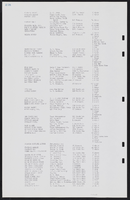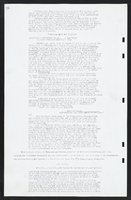Search the Special Collections and Archives Portal
Search Results

University of Nevada, Las Vegas (UNLV) Spring 2020 commencement program
Date
Archival Collection
Description
Commencement program from University of Nevada, Las Vegas Commencement Programs and Graduation Lists (UA-00115).
Text

Transcript of interview with Kevin Brady by David G. Schwartz, September 7, 2016
Date
Archival Collection
Description
Text
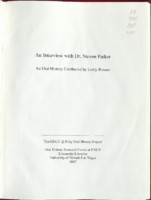
Transcript of interview with Dr. Steven Parker by Emily Powers, December 19, 2006
Date
Archival Collection
Description
Text
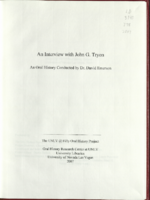
Transcript of interview with John G. Tryon by Dr. David Emerson, February 21, 2006
Date
Archival Collection
Description
Text
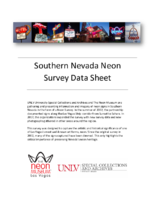
4 Mile Bar Neon Survey document, September 8, 2017
Date
Archival Collection
Description
Site name: 4 Mile Bar (Las Vegas, Nev.)
Site address: 3650 Boulder Hwy
Sign owner: Bob and Bill Joslin
Sign details: This is one of the most historic bars in Las Vegas. The original site of the bar was actually where one of the oldest communities in town began called Formyle. The community was there long before The Boulder Highway or US Highway 95. The area where the bar currently resides was called Four Mile Spring because it was "four miles from the center of town" and for the natural spring that was there. This part of town, for much of its history, was outside of Las Vegas city limits and outside of the laws for the rest of the city as well. This site was originally a brothel when it opened in the 1950s. In 1954, the property was raided by the FBI and then ended up turning into a bar. It is "one of the Valley's last true-blue roadhouses" and it is named because it sits four miles away from the Downtown area. They are also known for their very popular karaoke nights.
Sign condition: 4, the roadside sign is in good condition, but the sign that is attached to the building has some light bulbs that have been burned out on it.
Sign form: Roadside sign is a pole sign with a message center and there is an architectural sign attached to the facade of the building.
Sign-specific description: The road side portion of the signage for the 4 Mile Bar is fairly simple. The top of the sign features a plastic, backlit square that has a large red "4" and "MILE" in bold white text in the middle of the number. Underneath this is "BAR" in a bold red text against a white background. About a foot or two underneath this sign is a large plastic, backlit reader board. The main support for the sign is a white rectangular structure with two red stripes running down the center of it with a few inches of space between the lines. The architectural sign that is on the facade of the building is uncomplicated as well. The shape of it fits the top portion of the building and looks like a stretched out rectangle. All of the edges are lined by incandescent light bulbs. In the middle of the sign in open channel letters are the words "4 MILE BAR" that are filled with white glowing neon tubes.
Sign - type of display: Incandescent, neon and backlit plastic portion
Sign - media: Steel and plastic
Sign - non-neon treatments: Plastic
Sign environment: This bar sits at the cusp where Fremont Street transitions to Boulder Highway. Many of the immediate properties that sit near this bar are motels and mobile home communities. This is also just down the road from Boulder Station Hotel and Casino as well as the Winchester Cultural Center.
Sign - thematic influences: The roadside sign is very straightforward since it just displays the name of the bar, but there could have been a stylistic choice to use the actual number "4" instead of the word "four."
Sign - artistic significance: The most notable feature about this sign is the number "4" instead of the word "four" that is used, possibly for stylistic reasons.
Survey - research locations: Accessor's Page http://www.clarkcountynv.gov/assessor/Pages/searchbybusinessname.aspx, Review Journal articles https://storify.com/ReviewJournal/7-of-the-most-historic-bars-in-las-vegas and https://www.reviewjournal.com/uncategorized/over-a-century-four-mile-has-gone-from-trailside-oasis-to-brothel-to-bar/ , Vegas Seven article http://vegasseven.com/2013/06/12/las-vegas-bar-hall-fame/
Surveyor: Lauren Vaccaro
Survey - date completed: 2017-09-08
Sign keywords: Architectural; Incandescent; Neon; Backlit; Plastic; Steel; Pole sign; Roadside
Text

Gregory Koehler oral history interview: transcript
Date
Archival Collection
Description
Oral history interview with Gregory Koehler conducted by Claytee D. White on May 15, 2019 for the Remembering 1 October Oral History Project. Koehler begins talking about his family, early life, and occupation. He explains the line of jobs he has had, his history with firefighting, and how he moved to Las Vegas, Nevada in 2003. Koehler then recalls how he had attended the Route 91 Festival concert and the events that unfolded during the shooting. He describes what he saw, felt, and how he tried to help the people who were shot. Lastly, he talks about the aftermath of the event and the struggles he had gone through.
Text

Transcript of interview with Neil H. Holmes by Laura Bell, February 12, 1975
Date
Archival Collection
Description
On February 12, 1975, collector Laura Bell interviewed her neighbor, plant mechanic foreman, Neil H. Holmes (born on November 16th, 1897 in Chicopee, Kansas) in the collector’s home in Boulder City, Nevada. This interview covers the construction of Boulder (Hoover) Dam. During this interview Neil also discusses local living conditions in 1931.
Text


